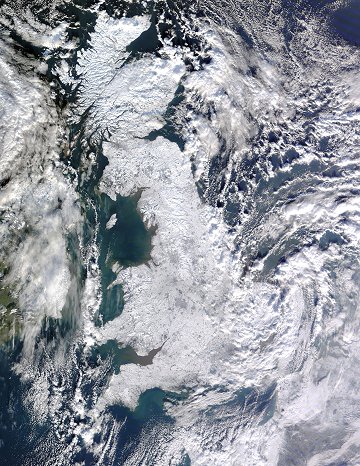Raybo
0
- Joined
- Oct 30, 2008
- Messages
- 537
- Points
- 18
Another tidbit.....
ISLAND SNOW: Last week when NASA's Terra satellite orbited over Europe, it saw something very unusual. The normally temperate British Isles were completely covered by snow. From an altitude of 420 miles, Terra's MODIS (Moderate-resolution Imaging Spectroradiometer) camera snapped this picture:
It's not only Britian. Heavy snowfall and record-low temperatures have spread across Europe, closing schools, paralyzing airports, and downing power lines. Much of North America and parts of Asia are experiencing the same brutal cold.
The cause of the phenomenon could be the Arctic Oscillation (AO). The AO is a seesawing strengthening and weakening of semi-permanent areas of low and high atmospheric pressure in the Arctic and the mid-latitudes. One consequence of the oscillation’s negative phase is cold, snowy weather in Eurasia and North America during the winter months. The extreme negative dip of the Arctic Oscillation Index in December 2009 was the lowest monthly value observed for the past six decades.
On the bright side, these conditions are ideal for many forms of atmospheric optics and fantastic patterns of frost on the ground and other surfaces.
ISLAND SNOW: Last week when NASA's Terra satellite orbited over Europe, it saw something very unusual. The normally temperate British Isles were completely covered by snow. From an altitude of 420 miles, Terra's MODIS (Moderate-resolution Imaging Spectroradiometer) camera snapped this picture:
It's not only Britian. Heavy snowfall and record-low temperatures have spread across Europe, closing schools, paralyzing airports, and downing power lines. Much of North America and parts of Asia are experiencing the same brutal cold.
The cause of the phenomenon could be the Arctic Oscillation (AO). The AO is a seesawing strengthening and weakening of semi-permanent areas of low and high atmospheric pressure in the Arctic and the mid-latitudes. One consequence of the oscillation’s negative phase is cold, snowy weather in Eurasia and North America during the winter months. The extreme negative dip of the Arctic Oscillation Index in December 2009 was the lowest monthly value observed for the past six decades.
On the bright side, these conditions are ideal for many forms of atmospheric optics and fantastic patterns of frost on the ground and other surfaces.
Last edited:




